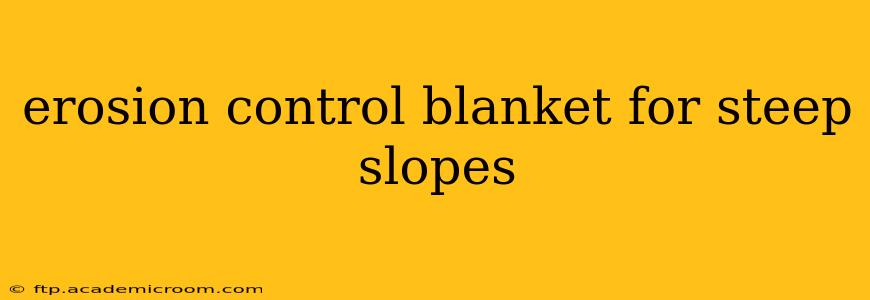Steep slopes present unique challenges when it comes to erosion control. The combination of gravity, rainfall, and wind can quickly lead to soil loss, impacting both the environment and infrastructure. Erosion control blankets offer a robust and effective solution, providing a protective layer that stabilizes the soil and promotes vegetation growth. This comprehensive guide will delve into the specifics of using erosion control blankets on steep slopes, addressing common questions and concerns.
What are Erosion Control Blankets?
Erosion control blankets are engineered fabrics designed to protect soil from erosion. They come in various materials, including biodegradable and non-biodegradable options, each suited to different applications and environmental conditions. These blankets are typically composed of natural or synthetic fibers, sometimes reinforced with netting or other stabilizing elements. Their primary function is to hold the soil in place while allowing water to infiltrate gradually, reducing runoff and the risk of erosion. On steep slopes, their ability to interlock with the soil and resist slippage is crucial.
What Types of Erosion Control Blankets are Best for Steep Slopes?
The ideal erosion control blanket for a steep slope depends on several factors, including the slope's angle, soil type, climate, and vegetation goals. Generally, heavy-duty blankets with high tensile strength and excellent anchoring capabilities are preferred. These often include:
- Coir blankets: Made from coconut fibers, these are biodegradable and environmentally friendly, promoting natural vegetation growth. Their natural fibers provide excellent soil binding and water retention. However, they might not be as strong as synthetic options on extremely steep slopes.
- Jute blankets: Similar to coir, jute blankets are biodegradable and offer good soil stabilization. They are often combined with other materials to enhance their durability.
- Synthetic blankets: These are typically made from polypropylene or other durable synthetics. They offer superior strength and longevity compared to natural fiber blankets, making them suitable for extremely steep slopes and challenging conditions. However, they are not biodegradable.
How are Erosion Control Blankets Installed on Steep Slopes?
Installing erosion control blankets on steep slopes requires careful planning and execution. The process generally involves:
- Site Preparation: Clearing the slope of debris, leveling uneven surfaces, and preparing the soil are essential for proper blanket installation.
- Blanket Placement: The blanket is unrolled carefully, ensuring even coverage and minimal wrinkles. On steep slopes, it’s often necessary to work in sections, securing each before moving on.
- Anchoring: Secure the blanket using appropriate methods, such as staples, pins, or netting. The anchoring method must be robust enough to withstand the forces of gravity and water runoff. This step is crucial on steep slopes to prevent slippage.
- Seeding/Hydroseeding: Following blanket installation, the slope is seeded or hydroseeded to establish vegetation, which further stabilizes the soil and enhances the longevity of the erosion control measures.
How Long Do Erosion Control Blankets Last on Steep Slopes?
The lifespan of an erosion control blanket on a steep slope varies depending on the material, climate, and environmental conditions. Biodegradable blankets will eventually decompose, typically within a year or two, while synthetic blankets can last for several years, sometimes even longer. The rate of decomposition and the overall lifespan can also be influenced by sun exposure and soil moisture levels.
What are the Costs Associated with Using Erosion Control Blankets on Steep Slopes?
The cost of erosion control blankets varies widely depending on factors such as the type of blanket, quantity needed, and installation costs. Synthetic blankets are generally more expensive upfront than biodegradable options, but their longer lifespan can make them a cost-effective choice in the long run. Installation costs are highly dependent on the slope's accessibility and the complexity of the project. It is best to consult with professional contractors to obtain precise cost estimates.
Are there Alternatives to Erosion Control Blankets for Steep Slopes?
Yes, several alternatives exist, each with its own advantages and disadvantages. These include:
- Hydroseeding: Applying a slurry of seed, mulch, and fertilizer directly to the slope. This is often used in conjunction with erosion control blankets.
- Erosion control mats: Similar to blankets but often thicker and more durable, suitable for extreme erosion challenges.
- Slope stabilization techniques: These might include terracing, retaining walls, or other structural measures. These are typically more expensive and disruptive than blankets.
What are the Environmental Impacts of Using Erosion Control Blankets?
The environmental impact depends on the type of blanket used. Biodegradable blankets are generally considered environmentally friendly, as they decompose naturally over time, leaving behind no harmful residue. Synthetic blankets, on the other hand, are not biodegradable and can contribute to plastic pollution if not disposed of properly. It is important to choose a blanket material that aligns with environmental sustainability goals.
By carefully considering the factors discussed in this guide, you can select and install the most suitable erosion control blanket for your specific steep slope project, ensuring long-term soil stability and environmental protection. Remember to always consult with qualified professionals for guidance and proper installation.
